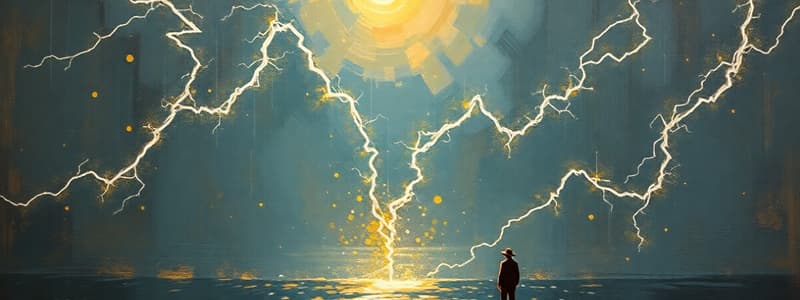Podcast
Questions and Answers
Which of the following devices uses electromagnets in its operation?
Which of the following devices uses electromagnets in its operation?
- Electric locks (correct)
- Fridge magnets
- Speakers
- Magnetic whiteboards
What is a key characteristic of an alloy?
What is a key characteristic of an alloy?
- It has the same properties as its component metals.
- It can only be created from two non-metals.
- It consists of two or more metals or a metal and another element. (correct)
- It is a pure metal.
What is the function of a voltmeter?
What is the function of a voltmeter?
- Measuring voltage (correct)
- Measuring resistance
- Measuring magnetic field strength
- Measuring current
Which statement about the generation of a magnetic field is true?
Which statement about the generation of a magnetic field is true?
In terms of electricity, what does 'potential difference' refer to?
In terms of electricity, what does 'potential difference' refer to?
What is the role of the independent variable in an experiment?
What is the role of the independent variable in an experiment?
What does the formula $I = \frac{Q}{T}$ represent?
What does the formula $I = \frac{Q}{T}$ represent?
Which of the following metals is commonly found in magnets?
Which of the following metals is commonly found in magnets?
What happens to an induced magnet when it is removed from a magnetic field?
What happens to an induced magnet when it is removed from a magnetic field?
What term describes the force that causes magnets to attract each other?
What term describes the force that causes magnets to attract each other?
Which of the following best describes the right hand grip rule?
Which of the following best describes the right hand grip rule?
How can you demagnetize a material?
How can you demagnetize a material?
What is the primary characteristic of ferromagnetic materials?
What is the primary characteristic of ferromagnetic materials?
Flashcards are hidden until you start studying
Study Notes
Independent, Dependent and Control Variables
- Independent variable: The factor that is changed or manipulated in an experiment.
- Dependent variable: The factor that is measured or observed in an experiment.
- Control variables: The factors that are kept constant throughout an experiment to ensure a fair test.
- Anomaly: An unusual or unexpected result that does not fit the general pattern of the data.
Electric Current
- Electric current: The flow of electric charge.
- Charge: The total number of coulombs that flow over a set time period.
- Coulombs (C): The unit of electric charge.
- Amps (A): The unit of electric current.
- Time (T): Measured in seconds (s).
Equations
- Current (I) = Charge (Q) / Time (T)
- Charge (Q) = Current (I) * Time (T)
- 1 Ampere (A) = 1 Coulomb (C) / 1 Second (s)
Magnets
- Magnetic field: The area around a magnet where a magnetic force can be felt.
- Permanent magnet: A magnet that retains its magnetism without the need for an external source.
- Magnetic poles: The ends of a magnet, labeled as North (N) and South (S).
- Attraction: The force that pulls two magnets together when opposite poles face each other.
- Repulsion: The force that pushes two magnets apart when the same poles face each other.
- Magnetic force: A non-contact force that acts between magnets and magnetic materials.
- Ferromagnetic materials: Materials that can be easily magnetized and retain their magnetism, such as iron, cobalt, and nickel.
- Earth's outer core: Contains liquid iron, a ferromagnetic material.
- Induced magnet: A material that becomes magnetic only when placed in a magnetic field.
- Magnetizing ferromagnetic materials: Can be done with methods like exposure to heat, using an external magnetic field, stroking, and electromagnetism.
- Demagnetizing materials: Methods include heating to a high temperature, dropping the material frequently, and hammering it.
Potential Difference
- Potential difference: The difference in electrical potential energy between two points in a circuit.
Magnetism and the Right Hand Grip Rule
- Right hand grip rule: Used to determine the direction of a magnetic field around a conductor carrying electric current.
- Thumb points in the direction of the current.
- Fingers curl around the conductor in the direction of the magnetic field.
Solenoids and Electromagnets
- Solenoid: A coil of wire that creates a magnetic field when an electric current flows through it.
- Electromagnet: A solenoid that produces a strong magnetic field, typically used in applications requiring controllable magnetic fields.
Everyday Uses of Magnets
- Fridge magnets
- Magnetic closures for bags
- Magnetic toys
- Speakers
- Magnetic whiteboards
- Earphones
Alloys
- Alloy: A mixture of two or more metals or a metal with another element, designed to create a material with unique properties.
Everyday Uses of Electromagnets
- Doorbells
- Speakers
- Hard drives
- Cranes and lifts
- Electric locks
- Maglev trains
- Electric generators
- Solenoid valves
- Electric motors
- MRI machines
Measuring Electrical Properties
- Voltmeter: Used to measure potential difference (voltage).
- Ammeter: Used to measure electric current.
Resistance in Circuits
- Resistance: A measure of how much a material opposes the flow of electric current - higher resistance limits current flow. The strong magnetic field created when current flows through a wire is a result of the resistance this wire has.
Making a Compass
- Compass: A device that uses the Earth's magnetic field to indicate direction. A simple compass can be made using a magnetized needle that will align with the Earth's magnetic field.
Studying That Suits You
Use AI to generate personalized quizzes and flashcards to suit your learning preferences.




